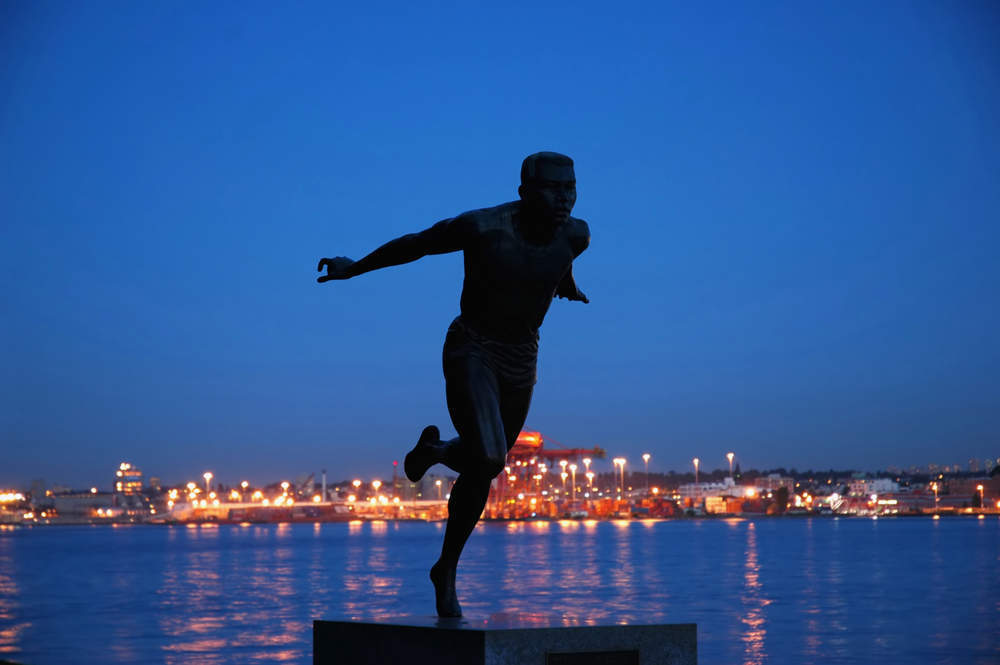
Sir Roger Bannister, the first person to run a mile in under four minutes, died on Sunday at the age of 88.
While his record time of three minutes 59.4 seconds stood for just 46 days, the iconic sporting moment was immortalised on camera by Norman Potter, an apprentice photographer working for Central Press.

Access deeper industry intelligence
Experience unmatched clarity with a single platform that combines unique data, AI, and human expertise.
Above is the famous photo and here’s the unlikely story of how it was taken
Compared to the highly-scientific training routines of today’s sports stars, Bannister was an unlikely record breaker. He viewed running as secondary to his medical studies at the University of Oxford and something to be done in his spare time.
Similarly, Norman Potter made for an unlikely photographer. After the loss of a finger cut short a career in the navy, he entered a career in Fleet Street as a runner boy in the hope of seeing famous athletes at the 1948 British Olympics.
On 6 May 1954, Potter crossed paths with the 25-year-old Bannister at Iffley Road sports ground in Oxford.

US Tariffs are shifting - will you react or anticipate?
Don’t let policy changes catch you off guard. Stay proactive with real-time data and expert analysis.
By GlobalDataHowever, when Norman arrived at the track it seemed unlikely that the race would even go ahead, with a 15 miles per hour crosswind and gusts up to 25 miles per hour almost causing Bannister to call off the attempt.
Potter told Verdict in an interview last year:
On the grounds was a machine, a long tube with a propeller inside that measured the wind speed. It was hi-tech for its day, but in reality it looked very Heath Robinson.
The other photographers took one glance at the wind speed and most of them decided to leave. I decided to stay.
Norman stayed partly through logic and partly through fear: he hoped that on a circular track the wind would be behind Bannister for some of the time, and feared he’d ‘get a rollicking’ if he missed something.
Only two other photographers remained with Norman: Dennis Evans, a freelance from Associated Press, and Ivan Samson from the Oxford Mail.
Just after 6pm, there was a lull in the wind. Pacemakers Chris Chataway and Chris Brasher grew impatient and wanted to know if the race was on.
It was then that Bannister made his decision:
Yes – let’s do it.
The small crowd fell silent as the athletes waited on the start line. Nerves were at breaking point — so much so that Brashermade made a false start.
At the second attempt, they were away.
Brasher lead the pack until the third lap and then gave the lead to Chataway. Bannister hung back in second place, waiting to make his move.
Meanwhile, Potter remained poised at the finish-line, leaving enough space to his right for the runners to pass through. With 250 yards to go, Bannister overtook Chataway and gave it everything he had.
The crowd’s excitement grew.
“We could see the timekeepers indicating that something big could happen,” said Potter.
In the 1950s camera technology predated the widespread use of film. Instead, glass plates were used that had to be changed with each picture, meaning Potter only had one chance to photograph Bannister crossing the line.
As Bannister thundered towards the finish, Norman adjusted the focus and set the lens width and let his finger hover over the shutter release, pressing it at the exact moment Bannister crossed the line.
Without hesitation, he withdrew the exposed plate and put it in his left pocket, took an unused plate from his right pocket and placed it inside the camera.
He ran back through the crowd with the camera held high above his head and took a final picture of Bannister in a state of collapse and gasping for air.
It took almost three minutes after the race for the time to be confirmed.
A silence fell over the track as timekeeper Norris McWhirter announced the results over the public-address system. The crowd never heard the full time, their screams drowning out McWhirter as soon as they heard the word “three”.
Potter said:
Dennis and I looked at each other but didn’t say a word. We knew we had just recorded history in the making but we were both thinking the same thing: We needed to get back to London — fast.
Surprisingly, Potter faced resistance getting the picture in print, with the deputy manager more concerned about going home.
It was 9:30pm so to the messenger boys and Fred it was time to shut up shop, regardless of a world record being broken.
Fortunately for Potter, darkroom assistant Larry Ellis helped argue the case to issue the picture of the record-breaking moment, and eventually twelve 10×8 prints were printed from both negatives.
The messenger boys rushed the prints to the national newspapers in Fleet Street, with Potter even running a couple himself.
The picture of Bannister went on to become synonymous with the record breaking event, and was widely used by press all around the world.
It would be another 50 years, however, before Potter received credit for the picture, after Getty Images purchased the Central Press photo library and darkroom assistant Larry Ellis recognised Norman’s work.
Matthew Butson, vice president of the Hulton Archive at Getty Images, told Verdict:
The classic Roger Bannister Four-Minute Mile shot is very typically ‘Norman’ – in the right place at the right time and a knack all the great Fleet Street photographers possessed.
However the shot is just one amongst many thousands in a career spanning over half a century which effectively documents our times – from ordinary people doing ordinary things, to extraordinary people doing extraordinary things.
The Bannister shot certainly fits into the latter category – one of the truly iconic sporting images from the 20th century and a fitting legacy to a one of the great unsung heroes of Fleet Street.
Years later Potter photographed Bannister in another race, this time against other dads at his son’s school sports day. He took it in secret with a long lens and had to get the headmaster’s permission to publish it.
While Bannister claimed he won, Potter insisted that this time he finished second.
Both men went on to have successful careers. In 1954 Bannister won a gold over the same distance at the Commonwealth games, but stopped running competitively to focus on a career in neurology. He was knighted in 1975.
Potter went on to work as a photographer for the Daily Mail and the Daily Express, covering numerous historic events and encountering many famous personalities before dying on 12 August 2017 at the age of 85.







